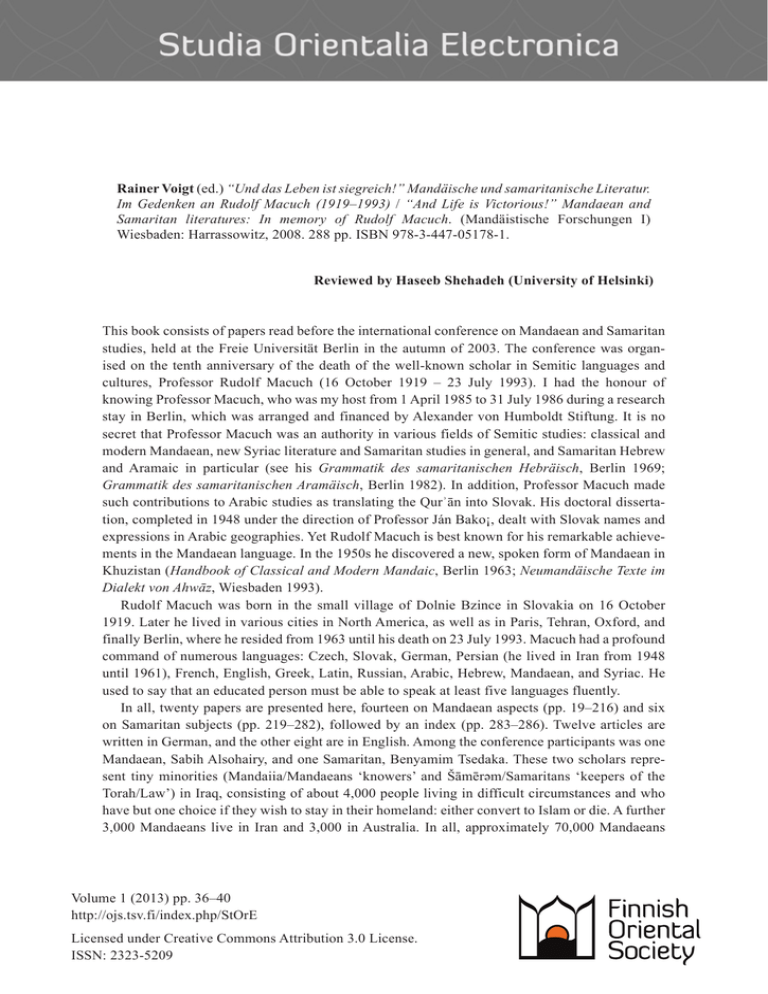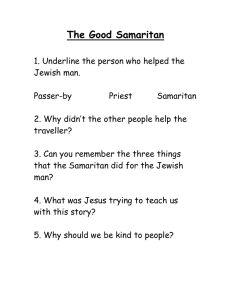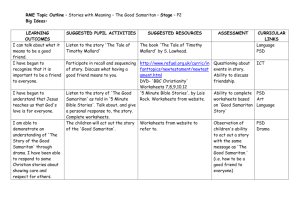Licensed under Creative Commons Attribution 3.0 License. ISSN
advertisement

Rainer Voigt (ed.) “Und das Leben ist siegreich!” Mandäische und samaritanische Literatur. Im Gedenken an Rudolf Macuch (1919–1993) / “And Life is Victorious!” Mandaean and Samaritan literatures: In memory of Rudolf Macuch. (Mandäistische Forschungen I) Wiesbaden: Harrassowitz, 2008. 288 pp. ISBN 978-3-447-05178-1. Reviewed by Haseeb Shehadeh (University of Helsinki) This book consists of papers read before the international conference on Mandaean and Samaritan studies, held at the Freie Universität Berlin in the autumn of 2003. The conference was organised on the tenth anniversary of the death of the well-known scholar in Semitic languages and cultures, Professor Rudolf Macuch (16 October 1919 – 23 July 1993). I had the honour of knowing Professor Macuch, who was my host from 1 April 1985 to 31 July 1986 during a research stay in Berlin, which was arranged and financed by Alexander von Humboldt Stiftung. It is no secret that Professor Macuch was an authority in various fields of Semitic studies: classical and modern Mandaean, new Syriac literature and Samaritan studies in general, and Samaritan Hebrew and Aramaic in particular (see his Grammatik des samaritanischen Hebräisch, Berlin 1969; Grammatik des samaritanischen Aramäisch, Berlin 1982). In addition, Professor Macuch made such contributions to Arabic studies as translating the Qurʾān into Slovak. His doctoral dissertation, completed in 1948 under the direction of Professor Ján Bako¡, dealt with Slovak names and expressions in Arabic geographies. Yet Rudolf Macuch is best known for his remarkable achievements in the Mandaean language. In the 1950s he discovered a new, spoken form of Mandaean in Khuzistan (Handbook of Classical and Modern Mandaic, Berlin 1963; Neumandäische Texte im Dialekt von Ahwāz, Wiesbaden 1993). Rudolf Macuch was born in the small village of Dolnie Bzince in Slovakia on 16 October 1919. Later he lived in various cities in North America, as well as in Paris, Tehran, Oxford, and finally Berlin, where he resided from 1963 until his death on 23 July 1993. Macuch had a profound command of numerous languages: Czech, Slovak, German, Persian (he lived in Iran from 1948 until 1961), French, English, Greek, Latin, Russian, Arabic, Hebrew, Mandaean, and Syriac. He used to say that an educated person must be able to speak at least five languages fluently. In all, twenty papers are presented here, fourteen on Mandaean aspects (pp. 19–216) and six on Samaritan subjects (pp. 219–282), followed by an index (pp. 283–286). Twelve articles are written in German, and the other eight are in English. Among the conference participants was one Mandaean, Sabih Alsohairy, and one Samaritan, Benyamim Tsedaka. These two scholars represent tiny minorities (Mandaiia/Mandaeans ‘knowers’ and Šāmērǝm/Samaritans ‘keepers of the Torah/Law’) in Iraq, consisting of about 4,000 people living in difficult circumstances and who have but one choice if they wish to stay in their homeland: either convert to Islam or die. A further 3,000 Mandaeans live in Iran and 3,000 in Australia. In all, approximately 70,000 Mandaeans Volume 1 (2013) pp. 36–40 http://ojs.tsv.fi/index.php/StOrE Licensed under Creative Commons Attribution 3.0 License. ISSN: 2323-5209 Book Review 37 are scattered around the globe. The Samaritans number roughly 750, and they live in the cities of Nablus in the Western Bank and Ḥolon near Tel Aviv. Thus, most of the Mandaeans today live in the Mandaean Diaspora, and their national and holy language is an eastern dialect of Aramaic. The Samaritans, whose holy language is western Palestinian Aramaic, are only to be found living near their holy place, Mount Gerizim in Nablus and Ḥolon. The members of these two sects do not speak their old languages, but rather the languages of their environment, meaning Arabic, Hebrew, and European languages. Yet the people are neither Arabs, Muslims, Christians, nor Jews. The main body of literature of these two sects, which are made up of the followers of John the Evangelist (also known as John the Baptist, Iahia Iuhana) and the followers of Moses the Prophet, is basically religious and revolves around the Ginza Rabba (in eighteen parts) and the Torah. The volume begins with a foreword by the editor and conference organiser, Professor Rainer Voigt (the head of the Seminar für Semitistik und Arabistik at the Freie Universität Berlin). Then follows an essay by Professor Maria Macuch, the daughter of Rudolf Macuch, about her “wise and loving” father (pp. 9–16). In undertaking the difficult task of making a brief survey, Maria Macuch touches on various points about her father as a scholar and, in particular, as a person. Rudolf Macuch grew up in a very poor peasant family, “brought up in a somewhat narrowminded Lutheran environment” (p. 10). Maria tells how, on his first day of school at the age of six, the child Rudolf stood in front of his class and asked the teacher: “What is the meaning of alpha et omega?” He surely did not hear this expression at home, but rather must have come across it in his extensive reading. Studying theology at the University of Bratislava (in Preßburg) changed his attitude to religion entirely. Among his teachers were Bakoš, Blachère, Sauvaget, Dhorme, Dupont-Sommer, Février, and Virollaud. Although Macuch became a priest in 1943, for a long time he did not work in the church because he did not believe in its dogma and did not wish to deceive his congregation. In this regard Maria adds, “He loved Jesus of Nazareth and Christian values, which he practised all his life” (p. 11). Macuch serves as a good example of a fieldwork researcher of Mandaean in Iran and of Samaritan Hebrew and Aramaic in Nablus. During his several trips to the Samaritan community in Nablus and with the assistance of his student, Professor Zuhair Shunnar, who originally came from Nablus, Macuch succeeded in purchasing forty-two modern Samaritan manuscripts. Shunnar briefly describes these manuscripts in his Katalog samaritanischer Handschriften (Berlin-West 1974). Maria Macuch asserts that her father “managed to establish the most extensive library on Samaritan Studies in the whole world, including rare and valuable manuscripts” (p. 14); however, the basis for this claim is not forthcoming. The section on Mandaeism includes the importance of Macuch’s research to the Mandaeans/ Sabians/Nasoraeans in Iraq; Mandaean origins and earliest history; the development of the Mandaean script (is it derived from an Iranian or an Aramaic source?); the mathematics and astronomy of the Mandaeans; Islamic influence and speculations in Mandaic literature and traditions; a Mandaean creation report and Genesis 1, a Mandaic text annotated and translated into German; preliminary remarks on an edition of rituals taken from the Drower Collection 50; the language of Mandaic incarnation bowls in early Islam; the Mandaeans (and not Mandaans as occurs on pp. 128–143) and the myth of their origins (the Mandaean version of creation and the four ages of mankind, as well as theories about their origin, either Egyptian or Palestinian). All of these studies have been carried out on the basis of Mandaean sources. Mention should be made here that not every Arab is Muslim (as is stated, for example, on p. 138). Other themes Studia Orientalia Electronica 1 (2013): 36–40 Book Review 38 taken up are a child from a high-level sky-birth (emruma) and the figure of John the Baptist (Iahia Iuhana), according to Mandaeans (short texts, translation, and comments); Mandaean baptismal rites in light of manuscript 27 from the Drower Collection (meaning and goal); the Mandaeans today (a survey of Mandaean Arabic publications in Iraq and in the Diaspora, and the problem of preserving cultural identity in small groups in foreign countries); preliminary remarks on the unpublished manuscript DC 40-Šapta ḏmihla, known as “the scroll of salt” (in particular, classical Mandaean, consisting of 1,137 lines of incantations and copied in 1832, containing a plethora of proper names). There is a discussion of Mandaean metrics and a detailed description of style and (syllable) structure of Mandaean poetry, based on a sample (a prayer) taken from the work of Mark Lidzbarski (1920). In the section on Samaritanism, there are articles on the following topics: the concept of the oldest Samaritan Law; definitions of the Terminus Thechnicus κανών and the oldest Samaritan concept of the Torah, which was characterised by respect for Moses’ tradition and a refusal to accept other scriptures; Samaritan cantillation, including a general description of the pure vocal music passed from father to son, and two choirs and two styles – one heavy, one light – as well as an explanation of sidrē miqrāta; common features shared with the Jewish Yemenite tradition; and a discussion of Samaritan Passover offerings on the basis of quotations dating from the second half of the nineteenth century to the beginning of the twentieth, with one of the main points concerning the right forelegs of sacrificial offerings (whether they should be burnt or given to the high priest). There are also some words in the Torah and in prayers that are read differently by contemporary Samaritans. We find investigations into semantic fields based on the al-Ṭabbāḫ, a central Halachic work written in Middle Arabic in the eleventh and twelfth centuries by Abū Al-Ḥasan (Ab Ḥisda) b. Marḥīv b. Māruth the Tyrian. Gerhard Wedel, the author of this particular article, published the first half of this Arabic text with a German translation and comments in 1987 as his doctoral dissertation, written under the supervision of Rudolf Macuch. In “Temple and Sacred Texts: A Samaritan and Jewish Perspective”, József Zsengellér examines the interaction between text and place, as well as their effect on religion. In addition, the relationship between canon and temple is discussed, along with the process of canonisation. In Judaism and Samaritanism, holy place determines the holiness of a book. One may well ask also, does not a sacred text make a place holy? Macuch’s name is often cited, despite the fact that almost none of the presentations deal directly with purely linguistic aspects of spoken and classical Mandaean or Samaritan Hebrew and Aramaic, topics that formed the core of Macuch’s research. Unfortunately, only four articles provide a list of sources at the end; the remaining articles give the sources in marginal notes. In one unfortunate instance, the reader discovers that the list of sources does not match those mentioned in the marginal notes. In his short article (pp. 19–27), Sabih Alsohairy surveys Macuch’s contribution to the revival of the Mandaean language (with mingled classic and modern features, plus Arabic influence) and religion, together with the contributions of other scholars such as Th. Nöldeke, M. Lidsbarski, W. Brandt, H. Petermann, L. Drower, and K. Rudolph. The author provides a list of Macuch’s writings on the history and language of the Mandaeans that have had an impact on the Iraqi Mandaeans. He also touches on various ideas concerning the original homeland of his ancestors and their various societies all over the world. He explains that the attitude of Iraqi Muslims towards the Mandaeans does not follow what is mentioned in the Qurʾān as Ahl Dhimma (see p. 71 ff.); instead, the Mandaeans are considered faithless. In addition, he raises Studia Orientalia Electronica 1 (2013): 36–40 Book Review 39 the problem of teaching and learning spoken Mandaean in the Diaspora – in Europe, the United States, and Australia – and how in some communities Mandaean religious books such as the Ginza Rabba are available. An Arabic translation of this major religious work was prepared for the first time by Alsohairy himself, together with Jusef Quzi, in 1998 in Baghdad. Today the priests (tarmidia) have double roles, which are religious as well as educational: they must teach the younger generations both religion and their national and holy language. Mandaeans in Iran and Australia speak a new Mandaean dialect among themselves, whereas Arabic is used in Iraq. Mandaeans today are endeavouring to preserve their identity by learning a new dialect of their old language and adhering to their religion (see Alsohairy’s dissertation, Die irakischen Mandäer in der Gegenwart, Hamburg 1975). Jorunn Jacobson Buckley pursues the topic of Mandaean origins, again on the basis of Rudolf Macuch’s theories, in order to suggest a different direction, at least with regard to the trade routes of emigration and the role of Ardban II or III. Macuch had accepted the tradition of the Mandaeans, which holds that Jerusalem was their original home (this is the so-called Palestine origins thesis, the other being the Babylon origins thesis). Other ideas and theses raised by various scholars such as E. Lupieri, V. Schou-Pedersen, J.B. Segal, J. Wiesehöfer, U. Kahrstedt, J. Naveh, Í. Gündüz, and Sh. Pines are discussed and “possible scenarios” suggested. The Mandaean source Haran Gawaita (inner/hidden Haran, Great Revelation) is dealt with at length in a consideration of its reliability as an historical source, and various interpretations of its wording are given. The author suggests that the Mandaeans in Babylonia in the late 1930s “understood themselves – and were seen by others – as Jews until then” (p. 42). Finally, Buckley is inclined to view the Mandaeans as “the earliest example […] possibly moving from Palestine to Media – creating our first evidence for Gnostic religiosity” (see his study The Mandaeans: Ancient Texts and Modern People, Oxford 2002). On the origin and development of the Mandaic Abagada (twenty-four characters, between Syriac and Arabic), Bogdan Burtea presents a systematic summary, which ranges from Nöldeke (1869) to Ch.G. Härbel (2006). In other words, the discussion includes theories of the alphabet’s eastern origin as well as its western origin. One opinion holds that Parthian chancery script gave rise to the scripts of such languages as Elymaic, Charcenean, and Mandaic between the second half of the first century and the end of the second century (p. 51). In “Mathematics and Astronomy of the Mandaeans”, Harald Gropp touches on several mathematical and astronomical points that he hopes will serve as “a start for future discussions” (p. 66). He writes, for example, that the Mandaean year is very precise, “up to half a minute” (p. 67). A clear focus is lacking here, however, and irrelevant themes such as the discovery of the Mandaeans, European travellers, Mandaean world history, and the alphabet are interpolated into the discussion. Şinasi Gündüz claims at the beginning of his article (pp. 71–86) that Mandaeism shares certain concepts, beliefs, and attitudes with Arabic Islam, despite the fierce polemics between these religions. The Arab prophet Moḥammad, called the “son of the slaughter, son of the demon Bizbat”, is consistently denigrated in Mandaic literature (p. 77). The profoundly negative image of Muslims expressed in Mandaic literature (Ginza, Haran Gawaita, Diwan Abatur, Drašia d Yahia, Alf Trisar, and especially in colophons) is presented in detail. The titles of both the previous article and this one do not successfully reflect what is included in the texts. Needless to say, the resemblance between the two religions does not automatically mean that Studia Orientalia Electronica 1 (2013): 36–40 Book Review 40 one made an impact on the other. In the article’s last four pages, which deal with the so-called “Islamic influence”, no clear case of irrefutable influence is shown. Erica C.D. Hunter’s paper is a pilot study that focuses on the orthography and language of three Mandaic incantation bowls excavated in Nippur in 1989. These bowls date back to the Umayyad period of classical Mandaic works, and their textual features are compared with specimens from Khouabir and Kutha (see Edwin M. Yamauchi, Mandaic Incantation Texts, New Haven 1967). The article suffers from a number of linguistic mistakes (pp. 251, 274, 275, 276, 279, 280, 281). The Samaritan Benyamim Tsedaka (pp. 247–253) discusses an ordinary phenomenon that is related to different readings of certain words in the Torah and prayers by contemporary Samaritans. This situation reflects centuries of oral transmission from various sources: an Ashkelon reading, a Cairo reading, a Damascus reading, a Gaza reading, a Nablus reading, and others. It should be pointed out that the Samaritan Pentateuch, unlike the Masoretic Pentateuch, has no Textus Receptus, and thus no canonisation. In the Samaritan Pentateuch, emphasis is placed on the oral tradition rather than on written text, which lacks any clear system of vocalisation in the ancient manuscripts. Contemporary editions of the Samaritan Pentateuch in Ḥolon and Nablus include vowels that can be different in controversial words. There are many words that have several pronunciations, even though their meaning is identical. The word ‘( עריםcities’) is pronounced ʿå:rǝm in twenty-four cases, as ʿarrǝm in thirteen cases, and as ʿārrǝm in one case (namely, Genesis 35:5; see Z. Ben-Ḥayyim, LOT, 4, Jerusalem 1977, p. 204). Sometimes the context in which a specific word occurs determines its pronunciation. The word ‘( שםname’) in a positive context is articulated as šam (Genesis 2:11, 3:20, 4:17, 19, and so on), whereas in a negative context the pronunciation is šem (Genesis 11:4). The verb ‘( ואהבתto love’, Leviticus 19:18) is pronounced today as waa ʾibta and waabta; the latter version is modern, as the author shows. Sometimes such controversies lead to brawls, grudges, and dissension among various families of Samaritans. Some cantors try to avoid disputes by reading neither waa ʾibta nor waabta, but uta ʾeb. A list of eight causes is given for contention over certain words in the Samaritan Pentateuch and prayers. These include misunderstandings, the refusal of dignitaries to admit their mistakes, different sources of oral transmission, context, and a positive or negative attitude towards God and towards human beings. One does not need to emphasise that the original Samaritan pronunciation of the Pentateuch and prayers is almost impossible to reconstruct. Such differences in pronunciation are affirmed in medieval Samaritan literature; המיתוāmītu ‘to urge’ – not īmītu ‘to kill’ (Exodus 4:24) – is a well-known example. Some attempts have been made to establish a Samaritan religious council in order to unify the pronunciation, but an important question arises with regard to the advantage of imposing a single reading that does not reflect the entire tradition of the Samaritans in their various locations in the Middle East: will the phonetically transliterated Samaritan Pentateuch prepared more than three decades ago by Z. Ben-Ḥayyim (LOT 4, Jerusalem 1977) function as the Textus Receptus in the future? This book is a useful resource for students of Semitic studies in general and for students of Mandaeism and Samaritanism in particular. We now await the publication of the second volume, the proceedings of the conference held in 2008 in Berlin, on the same two themes. Studia Orientalia Electronica 1 (2013): 36–40




